How to Fertilize Lemon Trees: Secrets for Thriving Citrus
- February 19, 2024
- 15 comment
Discover the secrets to thriving citrus with our guide on how to fertilize lemon trees effectively. Maximize growth and yield. Cultivating a lush, fruitful lemon tree in your backyard starts with understanding the nuances of fertilization. Whether you’re a seasoned gardener or a green-thumbed newbie, this article unveils the expert tips and techniques to ensure your citrus not only survives but thrives. From the best types of fertilizers to the optimal fertilizing schedule, we’ve got all the insights you need to nurture a bountiful lemon tree that’s bursting with life.
Table of Contents
- Understanding Lemon Tree Nutrition
- Types of Fertilizers for Lemon Trees
- Optimal Planting and Spacing for Lemon Orchards
- When and How to Fertilize Lemon Trees
- Training and Pruning Techniques for Healthy Lemon Trees
- Special Considerations for Potted Lemon Trees
- Advanced Citrus Care Tips
- Common Pests of Lemon Trees and Their Solutions
- Common Fertilization Mistakes to Avoid
- Conclusion
- FAQs
Understanding Lemon Tree Nutrition
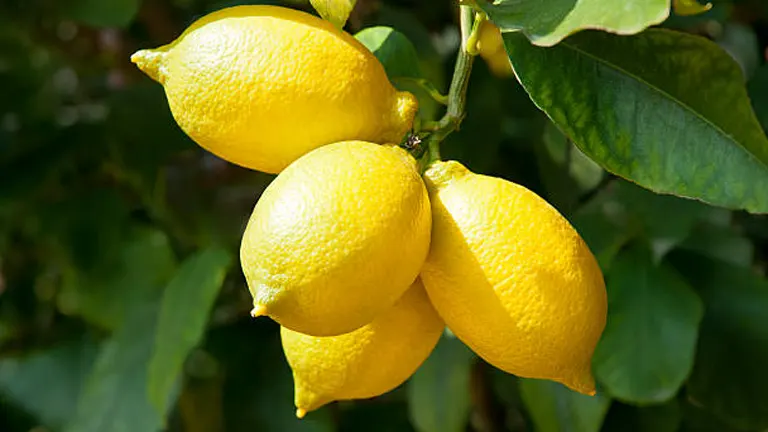
Lemon trees, emblematic of the citrus genus, require a meticulously balanced diet of essential nutrients to thrive, ensuring optimal growth, fruit production, and disease resistance. The nutritional needs of lemon trees can be categorized into macronutrients and micronutrients, each serving unique roles in the tree’s physiological development and metabolic processes.
Macronutrients: The Core of Lemon Tree Nutrition
- Nitrogen (N): Paramount for foliage development, nitrogen aids in synthesizing chlorophyll, the pigment responsible for the green coloration of leaves and essential for photosynthesis. A deficiency in nitrogen manifests as chlorosis, leading to the yellowing of leaves and reduced growth rates.
- Phosphorus (P): This nutrient plays a pivotal role in energy transfer within the plant, root development, and the maturation of fruits. Phosphorus deficiency can result in stunted growth, delayed fruiting, and dark green foliage.
- Potassium (K): Critical for water uptake and the activation of enzymes, potassium enhances the tree’s stress tolerance and disease resistance. Symptoms of potassium deficiency include leaf scorch and marginal browning.
Micronutrients: Vital for Preventing Deficiencies
- Iron (Fe): Essential for chlorophyll synthesis, iron deficiency often causes chlorosis, particularly in new leaves.
- Zinc (Zn): Zinc is crucial for the synthesis of plant growth hormones and enzyme activation. Deficiency symptoms include rosetting of leaves and stunted growth.
- Magnesium (Mg): As the central atom in the chlorophyll molecule, magnesium deficiency first appears as interveinal chlorosis in older leaves.
- Calcium (Ca): Important for cell wall structure and stability, calcium deficiency leads to tip burn in young leaves and blossom-end rot in fruits.
Nutrient Requirement Table for Lemon Trees
| Nutrient | Role in Plant | Deficiency Symptoms | Recommended Concentration | Generalized Description |
|---|---|---|---|---|
| Nitrogen (N) | Leaf growth, green color | Pale or yellow leaves, slow growth | 150-200 ppm | Essential for keeping leaves green and supporting growth. |
| Phosphorus (P) | Root and fruit development | Small or poorly formed fruits, dark leaves | 30-50 ppm | Supports the development of strong roots and healthy fruits. |
| Potassium (K) | Water regulation, stress resistance | Brown leaf edges, weak stems | 150-200 ppm | Helps the tree manage water better and stay resilient. |
| Iron (Fe) | Chlorophyll and photosynthesis | Yellow leaves with green veins | 100-150 ppm | Necessary for healthy, green leaves and effective photosynthesis. |
| Zinc (Zn) | Growth hormone production | Leaves small, bunched at stem | 50-100 ppm | Important for proper growth and development of the tree. |
| Magnesium (Mg) | Chlorophyll component | Older leaves turn yellow between veins | 25-50 ppm | Crucial for chlorophyll, which the tree needs to make food from sunlight. |
| Calcium (Ca) | Cell strength, growth | New leaves curled or with burnt tips | 150-200 ppm | Important for overall structural strength and growth of the tree. |
| Manganese (Mn) | Chlorophyll production, enzyme activation | Yellow leaves with green veins, brown spots | 50-100 ppm | Supports various critical functions for overall tree health. |
| Copper (Cu) | Photosynthesis, plant metabolism | Dark green, small new leaves | 20-30 ppm | Plays a key role in the tree’s energy creation and metabolism. |
| Boron (B) | Cell wall formation, fruit quality | Brittle growth, fruit cracking or hollow | 0.5-1.0 ppm | Vital for proper cell development and ensuring quality fruit. |
Note: The recommended concentration ranges are provided for soil application and can vary based on soil type, pH, and existing nutrient levels. Regular soil testing is advised to accurately tailor fertilization practices to the specific needs of lemon trees in different environments.
Types of Fertilizers for Lemon Trees
Selecting the appropriate fertilizer is a pivotal decision in citrus cultivation, influencing not only the health and productivity of the lemon tree but also the quality of the soil environment. Understanding the differences between organic, synthetic, slow-release, and liquid fertilizers—and their roles in nurturing lemon trees—is essential for optimizing tree care.
Organic Fertilizers: Organic fertilizers are made from natural plant or animal materials, including compost, manure, bone meal, and seaweed. They release nutrients slowly as they break down in the soil, providing a sustained nutrient supply that promotes healthy soil microbiome development. This gradual nutrient release helps prevent nutrient leaching and minimizes the risk of over-fertilization. Additionally, organic matter improves soil structure, enhancing water retention and aeration.
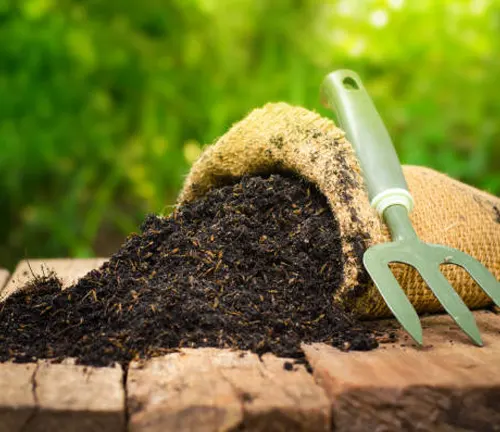
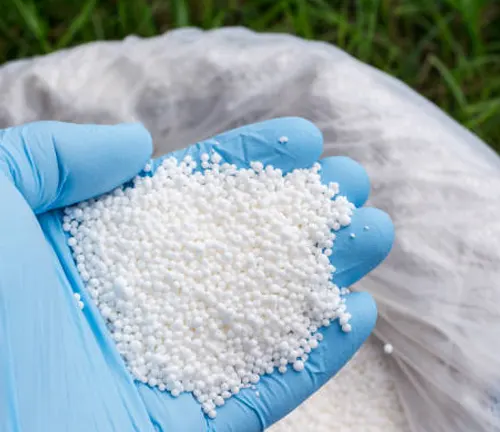
Synthetic Fertilizers: Synthetic (inorganic) fertilizers are chemically formulated to provide immediate nutrient availability to plants. They are typically higher in nutrient concentration compared to organic options and can be tailored to deliver specific nutrient ratios (N-P-K). While they offer the advantage of rapid nutrient release, this can also lead to salt accumulation in the soil if applied excessively or improperly, potentially harming the tree’s root system and beneficial soil organisms.
Slow-Release Fertilizers: Slow-release fertilizers, which can be either organic or synthetic, are designed to release nutrients gradually over time. This method reduces the frequency of application needed and diminishes the risk of nutrient runoff and leaching. For lemon trees, slow-release fertilizers ensure a consistent nutrient supply throughout their active growing seasons, supporting steady growth without the spikes in growth that can be caused by rapid nutrient release formulas.
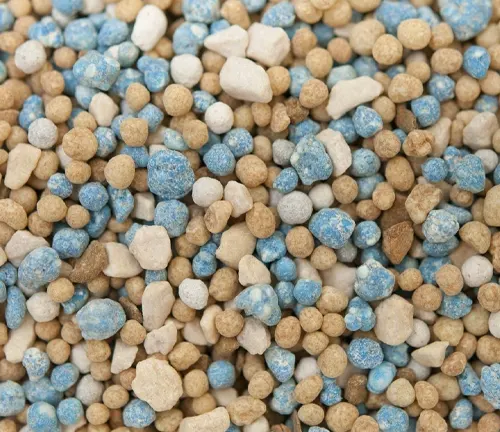
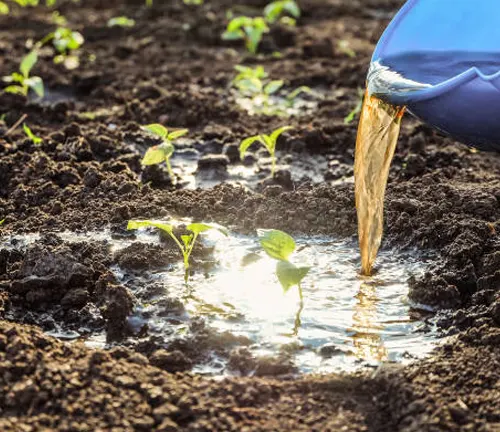
Liquid Fertilizers: Liquid fertilizers provide nutrients in a soluble form that is readily available for root uptake, making them ideal for addressing immediate deficiencies or giving young trees a quick growth boost. They can be applied through foliar feeding or directly to the soil. While they act quickly, their effects are short-lived, requiring more frequent application to maintain nutrient levels.
Fertilizer Comparison Table
| Fertilizer Type | Release Pattern | Nutrient Concentration | Best Use | Considerations |
|---|---|---|---|---|
| Organic | Slow | Variable, generally lower | Improving soil health, gradual nutrient supply | May need supplementation for specific deficiencies |
| Synthetic | Fast | High | Immediate nutrient needs, precise nutrient management | Risk of salt buildup, frequent application needed |
| Slow-Release | Controlled slow | Moderate to high | Sustained growth support, reduced application frequency | Initial cost higher, but more efficient over time |
| Liquid | Immediate | High | Quick remedy for deficiencies, foliar applications | Short-term effect, requires frequent application |
Selecting the right fertilizer for lemon trees involves balancing immediate nutritional needs with long-term soil health and environmental sustainability. Organic fertilizers enhance soil structure but may require supplementation, while synthetic options offer quick nutrient availability at the risk of salt buildup. Slow-release formulas provide a steady nutrient supply with less frequent application, and liquid fertilizers are ideal for quick fixes but need more regular application. The optimal approach often combines different types, tailored to the tree’s growth stage and soil conditions, aiming to support both the trees and the ecosystem they thrive in.
Scientific Insights:
- Nutrient Availability: The solubility and mobility of nutrients in soil vary; for instance, Nitrogen (as NO3-) is highly mobile and readily available, whereas Phosphorus (as H2PO4-) is less so, often requiring the action of soil microorganisms to become accessible to plants.
- Soil pH Impact: The effectiveness of fertilizers is heavily influenced by soil pH, with most nutrients being optimally available in slightly acidic conditions (pH 6.0-7.0). Synthetic fertilizers can sometimes alter soil pH, necessitating corrective measures.
Optimal Planting and Spacing for Lemon Orchards
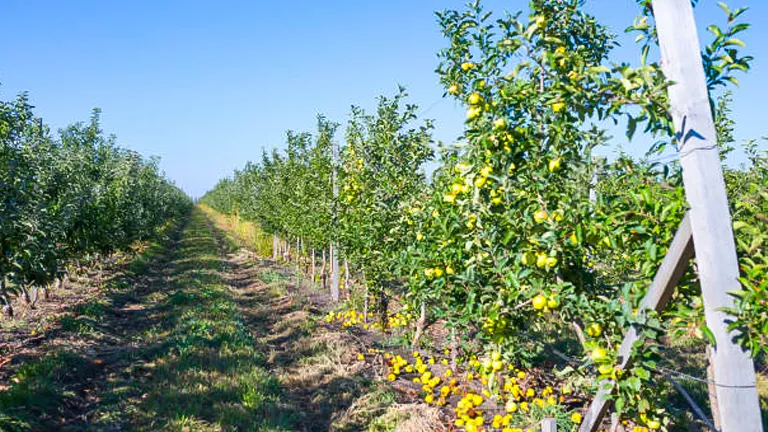
Achieving the right balance in planting and spacing is fundamental for the success of lemon orchards. It influences not only the health and productivity of each tree but also the efficiency of orchard management practices including irrigation, pest control, and harvesting.
Considerations for Spacing:
- Mature Tree Size: Lemon trees vary in size depending on the rootstock and variety. Dwarf varieties can be planted closer together (8-12 feet apart), while standard-sized trees require more space (15-25 feet apart) to reach their full productive potential without overcrowding.
- Sunlight Penetration: Adequate spacing is essential for maximizing sunlight exposure to the leaves, which is critical for photosynthesis and fruit production. A well-spaced orchard allows sunlight to reach the lower branches, promoting healthy growth throughout the entire canopy.
- Air Circulation: Proper air flow between trees reduces humidity around the foliage, minimizing the risk of fungal diseases such as citrus canker and greasy spot. Spacing should be adjusted based on local climate conditions, with more humid areas requiring wider spacing to facilitate air movement.
- Nutrient Availability: Close planting can lead to competition for soil nutrients, which may necessitate more frequent fertilization. Adequate spacing ensures that each tree has access to sufficient nutrients from the soil, reducing competition and the need for supplemental nutrition.
- Orchard Accessibility: Space between rows is crucial for accommodating orchard equipment used in pruning, spraying, and harvesting. Wider row spacing (20-30 feet) is recommended for orchards using larger machinery, while smaller equipment may allow for narrower rows.
Advanced Spacing Strategies:
- High-Density Planting: Some modern orchards employ high-density planting strategies to increase yield per acre in the early years of the orchard’s life. This approach requires careful management of pruning and rootstock selection to control tree size.
- Hexagonal Spacing: This arrangement maximizes the number of trees per unit area while ensuring each tree receives adequate sunlight and air circulation. It’s particularly useful in high-density setups, allowing for more efficient use of space.
- Interplanting with Pollinators: Incorporating pollinator-friendly plants between lemon tree rows can enhance biodiversity, improve pollination rates, and contribute to pest management by attracting beneficial insects.
When and How to Fertilize Lemon Trees
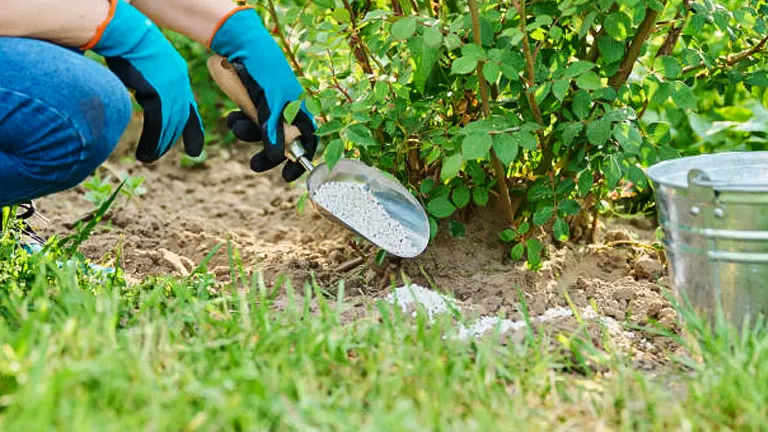
Timing is crucial when it comes to fertilizing lemon trees. The ideal period for applying fertilizer is from early spring through summer, aligning with the trees’ active growth phase. Young trees benefit from more frequent, lighter applications, ideally every two to three months during their first couple of years. Mature trees, however, should be fertilized less frequently, typically three times a year – in early spring, late spring, and summer – to support their growth and fruit production.
Lemon Tree Fertilization Schedule
Early Spring (Budding Phase):
- Timing: As new growth appears, typically in early spring.
- Purpose: Supports foliage and root development, setting the stage for the year’s growth.
Late Spring (Flowering Phase):
- Timing: Coincide with the tree’s flowering period.
- Purpose: Enhances bloom quality and supports fruit set, focusing on phosphorus to boost flower formation and fruit development.
Summer (Fruit Development Phase):
- Timing: During fruit development, usually in early to mid-summer.
- Purpose: Provides potassium to improve fruit size, flavor, and overall tree health during the fruiting stage.
Frequency Adjustments:
- Young Trees: Fertilize every 2-3 months with a lighter application to encourage growth without overwhelming the tree.
- Mature Trees: Stick to the three key fertilization points in the year. Adjust based on tree health, growth observations, and soil test results.
Annual Soil Test:
- Conduct a soil test annually, preferably in late fall, to tailor the fertilization plan to the tree’s specific needs for the upcoming year.
This schedule is designed to align with the natural growth cycles of lemon trees, providing nutrients precisely when they can be most effectively utilized by the tree. Regular observation and soil testing are crucial to adjust this schedule based on individual tree needs and local growing conditions.
Step-by-Step Guide to Fertilizing Lemon Trees
Step 1: Determine the Right Time for Fertilization
- Early Spring: Begin your fertilization schedule as new growth appears, signaling the tree’s exit from dormancy.
- Late Spring: Apply a second round of fertilizer when the tree starts flowering.
- Summer: A final application should be done when fruits are developing.
Step 2: Choose the Appropriate Fertilizer
- For Young Trees: Opt for a balanced, water-soluble fertilizer that can be easily adjusted and applied more frequently.
- For Mature Trees: Use a slow-release granular fertilizer to provide steady nutrition over several months or a balanced N-P-K formula according to the tree’s growth stage and soil test results.
Step 3: Soil Testing
- Conduct a soil test to determine the nutrient content and pH level, helping to tailor the fertilizer choice to your tree’s specific needs.
Step 4: Calculate the Required Amount of Fertilizer
- Follow the manufacturer’s recommendations based on the size and age of your tree. As a general rule, use about 1 pound of actual nitrogen per year of the tree’s age or per inch of trunk diameter, measured about a foot from the ground.
Step 5: Application Method
- Granular Fertilizer: Evenly distribute the fertilizer around the drip line of the tree, then lightly mix it into the soil with a rake. Avoid applying too close to the trunk to prevent root burn.
- Liquid Fertilizer: Dilute as per the product’s instructions and apply both to the soil around the drip line and as a foliar spray if needed. For foliar application, ensure it’s done during cooler parts of the day to avoid leaf burn.
Step 6: Watering
- Water the tree thoroughly after applying granular fertilizer to help dissolve the nutrients and encourage deeper penetration into the soil.
Step 7: Monitoring and Adjusting
- Observe your tree’s response to the fertilization over the following weeks. Look for signs of improved vigor, such as new leaf growth and general health. Adjust your fertilization practices based on the tree’s performance and additional soil tests.
Step 8: Incorporate Organic Matter
- Enhance soil health and nutrient availability by adding compost or well-rotted manure around the base of the tree. This organic matter also helps to improve soil structure and water retention.
Step 9: Repeat Soil Testing
- Conduct annual soil tests to monitor changes in nutrient levels and pH, adjusting your fertilization program as necessary to meet the evolving needs of your lemon tree.
Step 10: Record Keeping
- Maintain records of your fertilization schedule, amounts applied, and observations of the tree’s response. This information is invaluable for refining your approach over time.
Additional Tips
- Always wear protective gloves and follow safety instructions when handling fertilizers.
- Consider the local climate and weather conditions—fertilize after a period of heavy rain to replace leached nutrients but avoid fertilizing during drought conditions without adequate irrigation.
- Be mindful of environmental regulations and recommendations regarding fertilizer use to prevent runoff and pollution.
Training and Pruning Techniques for Healthy Lemon Trees
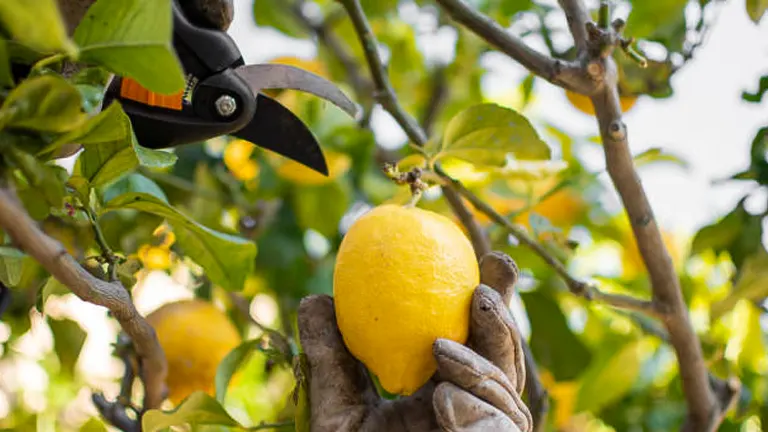
Foundation Training for Young Trees:
- Structural Training: Begin training your lemon tree during its first year by selecting 3-4 main branches to form the tree’s scaffold structure. These branches should be evenly spaced around the trunk, starting at least 18 inches from the ground to facilitate air flow and ease of harvest.
- Tip Pruning: Lightly prune the tips of the selected scaffold branches to encourage branching and denser foliage, which supports more fruit production in subsequent years.
- Stake Support: Provide young trees with stakes to ensure straight growth and protection against strong winds, carefully tying the tree to the stake without damaging the bark.
Pruning Techniques for Mature Trees:
- Seasonal Pruning: Conduct major pruning activities during the dormant season (late winter to early spring) to prepare the tree for vigorous spring growth. However, light pruning and removal of dead or diseased wood can be done anytime throughout the year as needed.
- Canopy Management: Aim to create an open canopy that allows sunlight to penetrate and air to circulate freely. This involves selectively thinning out crowded areas within the canopy and removing any branches that grow vertically or inward.
- Fruit Thinning: In cases of overbearing, where the tree produces more fruit than it can support, thinning the fruit can improve size and quality. This is done by gently removing excess fruit clusters in the early stages of development.
Specialized Pruning Strategies:
- Renewal Pruning: For older or neglected trees, renewal pruning may be necessary. This involves more drastic cuts to remove overgrown or unproductive branches, encouraging new growth from the base. This process may take several years, as it should be done gradually to avoid shocking the tree.
- Height Control: Keep the tree at a manageable height (6-8 feet) through careful pruning to facilitate easy harvesting and maintenance. This can involve cutting back the central leader and taller branches to lateral branches that can support the weight of the fruit.
Health and Disease Management:
- Disease Prevention: Regular pruning helps prevent diseases by removing parts of the tree that may be infected with pathogens. Good pruning practices, such as making clean cuts and sterilizing tools between cuts, can significantly reduce the spread of diseases.
- Wound Care: Apply a natural wound sealant to larger cuts to protect against disease and pest infestation. However, avoid using tar-based sealants as they can hinder the natural healing process of the tree.
Tools and Safety:
- Use sharp, clean pruning tools for clean cuts. Basic tools include hand pruners, loppers, and a pruning saw for larger branches.
- Wear protective gloves and eyewear to prevent injuries from thorns and flying debris.
By adopting these advanced training and pruning techniques, gardeners can ensure their lemon trees develop a robust structure, achieve optimal health, and produce abundant, high-quality fruit. Regular, mindful pruning not only shapes the tree but also addresses potential problems before they affect the tree’s overall wellbeing.
Special Considerations for Potted Lemon Trees
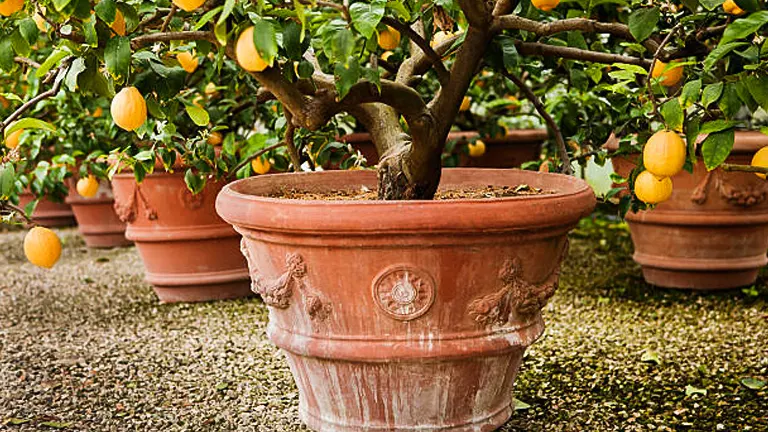
Caring for potted lemon trees presents a unique set of challenges and rewards, distinct from those associated with trees planted in the ground. The restricted environment of a container affects everything from soil composition to moisture levels, necessitating a tailored approach to ensure these vibrant citrus trees not only survive but thrive. Addressing these needs effectively allows gardeners to enjoy the beauty and bounty of lemon trees, even in limited spaces. Here’s a comprehensive list of care considerations to help potted lemon trees flourish:
Comprehensive Care for Potted Lemon Trees
- Optimal Soil Mix: Use a well-draining, loamy mix, ideally composed of two parts peat moss, one part perlite, and one part compost, to ensure proper drainage and nutrient retention.
- pH Balance: Maintain a slightly acidic soil pH (5.5 to 6.5), adjusting as necessary with lime or sulfur to create optimal growing conditions for your lemon tree.
- Balanced Nutrition: Select a balanced, slow-release fertilizer formulated for citrus trees, and consider micronutrient supplementation to compensate for the limited soil volume.
- Watering Practices: Keep the soil consistently moist but not waterlogged, and ensure pots have good drainage to prevent root rot.
- Pot Size and Repotting: Start with a pot slightly larger than the root ball and plan to repot every 2-3 years to encourage growth and refresh the soil.
- Location and Light: Position your tree where it will receive at least 6-8 hours of direct sunlight daily, moving it as needed to capture seasonal light.
- Temperature and Humidity: Protect the tree from extreme temperatures and maintain adequate humidity, especially if overwintering indoors.
- Pruning and Support: Regularly prune to manage size and shape, and provide staking or support as the tree grows to maintain stability and health.
Advanced Citrus Care Tips
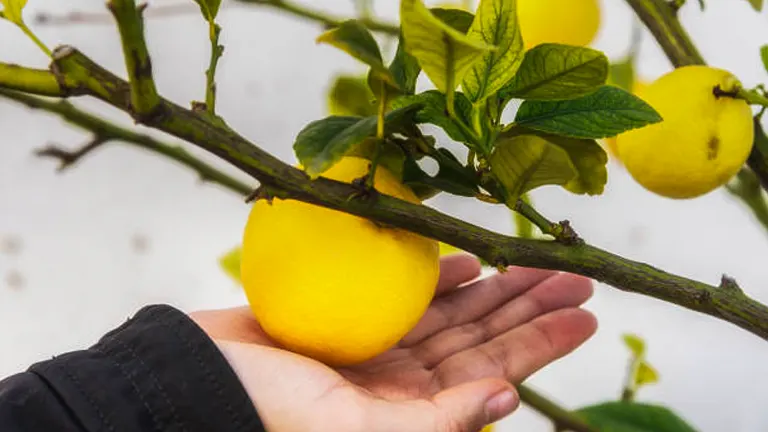
Achieving a thriving lemon tree requires more than just regular fertilization. Soil health, organic amendments, and understanding the micro-environment of your tree can significantly influence its growth and fruiting capacity.
Optimizing Soil Health:
- Biochar Addition: Incorporating biochar into the soil can further enhance its nutrient retention and water-holding capacity. Biochar, a form of charcoal made from organic matter, helps in creating a thriving environment for beneficial soil microbes, which in turn supports healthier tree growth.
- Regular Soil Testing: Conducting annual soil tests can provide invaluable insights into the soil’s nutrient levels, pH, and composition. This information allows for targeted amendments, ensuring your lemon trees have access to the essential nutrients they require.
Mulching Innovations:
- Living Mulches: Beyond traditional organic mulches, consider using living mulches, such as clover, which can improve soil health, add nitrogen, and maintain soil moisture while providing the additional benefit of attracting pollinators.
- Mulch Depth and Type: Experiment with different mulch materials such as straw, bark, or leaf litter to determine which best suits your soil type and climate. Adjusting the depth based on seasonal needs can also be beneficial; for instance, a thicker layer may be applied in summer to conserve moisture and in winter to provide insulation.
Companion Planting Strategies:
- Diversity is Key: Introduce a variety of companion plants to create a balanced ecosystem. Flowers like lavender and herbs such as basil not only deter pests but can also attract beneficial insects that provide pollination support and pest control.
- Strategic Placement: Position companion plants to maximize their benefits; for example, taller plants can provide shade for the lemon tree’s root zone in hot climates, reducing water evaporation and cooling the soil.
Adapting to Seasonal Changes:
- Winter Protection: In areas with mild winters, consider using frost cloths or constructing a temporary greenhouse around your lemon tree to protect it from cold snaps. This can extend the growing season and protect the tree from frost damage.
- Summer Care: Implementing shade cloth during the peak summer months can prevent sunburn on the leaves and fruits, especially in regions with intense sunlight.
Water Management Techniques:
- Drip Irrigation: Employing a drip irrigation system can ensure deep watering that reaches the roots, minimizing evaporation and saving water. This method also reduces the risk of fungal diseases by keeping foliage dry.
- Hydrogel in Soil: Mixing water-absorbing hydrogel crystals into the potting mix for container-grown lemon trees can help maintain consistent soil moisture, particularly beneficial during hot, dry periods.
Advanced Pest and Disease Management:
- Integrated Pest Management (IPM): Implement an IPM strategy by monitoring for pests and diseases regularly, using physical barriers (such as netting), encouraging natural predators, and applying organic pesticides only as a last resort.
- Disease Prevention: Practice good sanitation by removing fallen leaves and fruit, which can harbor pests and diseases. Ensure proper pruning to improve air circulation within the canopy, reducing the risk of fungal infections.
By integrating these advanced care tips into your gardening practices, you can create an optimal environment for your lemon trees to flourish. These strategies not only enhance the health and productivity of your trees but also contribute to a more sustainable and eco-friendly garden ecosystem.
Common Pests of Lemon Trees and Their Solutions
- Citrus Aphids are small, pear-shaped insects that tend to cluster on new growth of lemon trees. They can cause significant damage by causing leaves to curl and excrete honeydew, which leads to the growth of sooty mold. To combat these pests, it’s recommended to introduce natural predators, such as ladybugs, and use insecticidal soap or neem oil for heavy infestations.
- Citrus Leafminer pests are moth larvae that create distinctive squiggly lines inside the leaves, leading to distorted or stunted leaves and reduced tree vigor. Effective solutions include applying pheromone traps to capture adults, encouraging natural predators like parasitic wasps, and using systemic insecticides judiciously.
- Scale Insects, small and stationary, attach themselves to the stems, leaves, and fruit, sucking the sap and weakening the tree. This can result in leaf drop and even branch death. Minor infestations can be scraped off, while larger issues may require the application of horticultural oil or neem oil. Systemic insecticides are also an option for severe cases.
- Spider Mites are tiny spider-like pests often found on the undersides of leaves, causing speckled, discolored, or dried-out leaves and weakening the trees. Increasing humidity around the tree can deter mites, and the use of miticides or insecticidal soap can control them. Predatory insects like lacewings are also beneficial.
- Citrus Thrips are small, slender insects that damage flowers and young fruit, resulting in scarred fruit surfaces, distorted leaves, and stunted growth. Solutions include applying reflective mulch around trees to repel thrips, using appropriate insecticides during vulnerable growth stages, and introducing or encouraging natural predators.
- Citrus Psyllid pests are winged insects known for spreading citrus greening disease, which can cause misshapen, bitter fruit and potentially lead to tree death. Strategies to manage these pests include removing and destroying infested plant parts, using insect-proof netting to protect young trees, and applying systemic insecticides carefully to control psyllid populations.
General Prevention and Management Tips:
- Regular Monitoring: Early detection through regular inspection of your lemon trees is critical for managing pest populations effectively.
- Cultural Practices: Maintain tree health with proper nutrition and water. Sanitize pruning tools and manage weeds to reduce pest habitats.
- Biological Control: Foster a garden environment that supports the natural enemies of these pests. This can include planting flowers that attract beneficial insects or releasing commercially available predators.
- Chemical Control: Use pesticides as a last resort and select products that are specific to the pests you are targeting to minimize environmental impact. Always follow the label instructions for safe and effective use.
Common Fertilization Mistakes to Avoid
A successful fertilization program also means being aware of potential pitfalls. Here are some critical mistakes to avoid:
- Over-Fertilization: Avoid excessive fertilizer application, which can cause nutrient imbalances, salt accumulation, and root burn.
- Neglecting Soil pH: Regularly test and adjust soil pH to maintain the slightly acidic range (pH 6.0-7.0) ideal for lemon trees.
- Ignoring Specific Nutritional Needs: Customize your fertilization plan to meet the unique needs of your lemon tree variety, considering its age, health, and production phase.
- Symptoms of Excess Nutrients: Look out for signs of over-fertilization, like leaf burn or rapid, weak growth.
- Corrective Measures for Over-Fertilization: Leach the soil with deep watering to flush out excess salts if over-fertilization occurs.
- Impact of Soil pH on Nutrient Availability: Understand that soil pH affects the availability of certain nutrients, and adjust soil amendments accordingly.
- Micronutrient Attention: Ensure trees receive essential micronutrients; consider foliar sprays for quick correction of deficiencies.
- Uniform Application: Distribute fertilizer evenly around the drip line, not just near the trunk, to encourage healthy root spread.
- Root Zone Fertilization: Fertilize considering the full extent of the root system, which often extends beyond the drip line in mature trees.
- Incorporating Organic Matter: Enhance soil structure and fertility by adding compost or well-rotted manure, especially important for potted lemon trees.
- Watering Practices Post-Fertilization: Water adequately after applying fertilizer to help nutrients reach the root zone without causing nutrient leach.
By adhering to this concise list of fertilization practices, gardeners can effectively nurture their lemon trees, avoiding common pitfalls and fostering optimal growth and productivity.
Related Post
- How to Fertilize Bougainvillea: A Complete Guide for Stunning Blooms
- How to Fertilize Apple Trees: Essential Tips for a Bountiful Harvest
- How to Fertilize Lemon Trees: Secrets for Thriving Citrus
- How to Fertilize Avocado Tree: A Step-by-Step Guide for Lush Growth
Conclusion
Fertilizing lemon trees effectively is a blend of art and science, requiring a deep understanding of the tree’s nutritional needs, the timing of application, and the nuances of tree care. By following the guidelines outlined in this article, from selecting the right type of fertilizer to mastering pruning techniques and avoiding common mistakes, you can ensure your lemon trees remain healthy, vibrant, and productive.
Whether you’re nurturing a single potted lemon tree on your balcony or overseeing an orchard, the secrets to thriving citrus lie in attentive care, tailored practices, and a commitment to understanding the unique ecosystem that lemon trees inhabit. With patience and precision, your efforts will be rewarded with bountiful harvests of juicy, flavorful lemons.
FAQs
- What is the best time of year to fertilize lemon trees?
Lemon trees should be fertilized during their active growth period, from early spring through summer. This typically means applying fertilizer in early spring, late spring, and again in summer for mature trees. Young trees can benefit from more frequent, lighter applications every two to three months. - How can I tell if my lemon tree is lacking nutrients?
Signs of nutrient deficiency include yellowing leaves (lack of nitrogen), slow growth or small, poorly developed fruits (phosphorus deficiency), and weak stems or leaf curling (potassium deficiency). Micronutrient deficiencies can also manifest as discoloration or spotting on leaves. - Can I use the same fertilizer for my lemon tree that I use for other plants?
Lemon trees have specific nutritional needs, different from other plants. It’s best to use a fertilizer formulated for citrus trees, which will have the correct balance of nitrogen, phosphorus, potassium, and essential micronutrients. - How do I apply fertilizer to my lemon tree?
For granular fertilizers, evenly distribute the recommended amount around the drip line of the tree, then lightly rake it into the soil and water thoroughly. For liquid fertilizers, dilute as directed and apply to the soil at the base of the tree. - What should I do if I’ve over-fertilized my lemon tree?
If you suspect over-fertilization, water the tree deeply several times over a week to help flush out excess nutrients. Avoid fertilizing again until the tree shows signs of recovery, such as new leaf growth. - Is organic or synthetic fertilizer better for lemon trees?
Both organic and synthetic fertilizers can be effective. Organic fertilizers improve soil health over time and release nutrients slowly, while synthetic fertilizers offer a quick nutrient boost. The choice depends on your gardening practices and the immediate needs of your tree. - How often should potted lemon trees be fertilized compared to those in the ground?
Potted lemon trees typically require more frequent fertilization than those planted in the ground due to limited soil volume and nutrient availability. However, use a lighter hand with each application to prevent salt buildup in the potting soil. - Can mulching affect how I fertilize my lemon tree?
Mulching can help maintain soil moisture and temperature, reducing stress on the tree and potentially enhancing nutrient uptake. However, ensure the mulch is not in direct contact with the tree’s trunk and that you adjust your fertilization to account for any additional
In wrapping up our journey through the essentials of fertilizing lemon trees, remember that the key to vibrant and fruitful citrus lies in understanding their nutritional needs and responding with care. By selecting the right fertilizer, timing your applications just right, and tuning into the unique needs of your tree, you’re setting the stage for lush growth and bountiful harvests. Happy gardening!

Benjamin Brooks
Forestry AuthorGreetings! I'm Benjamin Brooks, and my journey over the past 15 years has revolved around the fascinating realms of content creation, expertise in snow clearing, and the intricate world of lumberjacking and landscaping. What began as a simple curiosity about the natural world and heavy machinery has evolved into a passionate profession where my love for crafting words intertwines seamlessly with my lumberjacking and garden skills.
15 comments
how many time is required for matchur tree for lemon
Nasir Saifi
February 27, 2024 2:47 pmLemon trees usually bear fruit in 3 to 5 years if grown from a grafted sapling, and a bit longer from seed. Proper care and fertilization, as highlighted in the guide, can help speed up this process and ensure your tree thrives!
Benjamin Brooks
March 4, 2024 6:49 amOur lemon tree is approximately 4 years old and looks healthy. However the fruit is small and under developed and from your excellent article this indicates a lack of phosphate. Can you recommend a specific fertiliser to address this problem? Would 2:3:2 be helpful?
Cora
February 27, 2024 2:04 pmThanks for sharing about your lemon tree and for the kind words about the article. It sounds like a 2:3:2 fertilizer could be a good choice to help with the fruit size, as it offers more phosphate which is what your tree might need. Just make sure to follow the application instructions on the package. Also, regular watering and enough sunlight are key for healthy growth. If you don't see improvement, a soil test might help to figure out if there's something else going on. Hope this helps, and best of luck with your lemon tree!
Benjamin Brooks
March 1, 2024 12:49 amI have planted lemon many times, and they all died, plenty fertiliser, and water, but leaf curve was all ways there. I have spray ed them many times and nothing helped.
Borislav
February 26, 2024 11:13 pmI'm sorry to hear about your lemon trees. Leaf curl can be a sign of over-watering, over-fertilization, or pests like aphids. Consider soil testing for proper nutrient balance and ensure good drainage to avoid waterlogging. Use citrus-specific fertilizer in recommended amounts, and monitor for pests, treating them as needed. Sometimes, less watering and fertilization can be beneficial. Best of luck with your next lemon tree!
Benjamin Brooks
March 4, 2024 6:33 amVery nice but no mention of pests ..citrus leafminer are the biggest scurge of new growth in Australia and can decimate new trees...they love the new growth but their are ways to work around them...I've been growing for 35 years in ground and pots...the key is the spring burst...I actually feed my trees in the last month of winter..to make sure nutrients are available for the spring burst..the temps are lower and CLM are not about at that time...they come with the warmth....they are after the nitrogen in new growth...so its a very bad idea to encourage autumn growth because it will.get monstered by CLM.... I favour organics in that winter feed...slow release troforte in the warmer months..little and often..around the outside ( esp pots) ...make the roots search for their food and improve rootball.volume....hope this helps other peeps.
Jonathan C Cox
February 26, 2024 10:31 amHi Jonathan C Cox, I apologize for not mentioning pests. You’re absolutely right considering pests like the citrus leafminer is crucial for successful lemon tree care. Thank you for highlighting this important aspect!
Benjamin Brooks
February 26, 2024 11:30 amIncredibly helpful information 👌 Will follow these instructions to the tee🍋Thank you for sharing.
Charmaine Aspeling
February 25, 2024 6:29 pmHealthy looking trees but few flowers and fruit 8 years old
Gillian Baxter
February 24, 2024 9:22 amGreat info on potting trees. All information is well appreciated. I have a keylime and a tango/ Lemon from Porchacal. Please keep me on your list. Thanks again
Ed Flamm
February 23, 2024 1:20 pmWhat kind of fertilizer do I need for trees that produce sour oranges
John
February 19, 2024 1:53 pmFor sour orange trees, use a citrus-specific fertilizer with a balanced N-P-K ratio like 6-6-6 or 8-8-8, ensuring it includes essential micronutrients such as magnesium, zinc, and iron. Follow the package instructions for application, typically starting in early spring through late summer.













My lemons drop off the tree as they ripen. Is this a sign of some deficiency? Would prefer to keep them on the tree where they stay fresh longest.
Harti Sieburg
February 28, 2024 7:54 amThanks for reaching out with your concern! It's pretty common for lemon trees to drop their fruit as they ripen, but I understand why you'd want to keep them on the tree longer. This could be happening for a few reasons, like not getting the right amount of water or needing more nutrients. Sometimes, even the weather playing tricks on us can affect the tree more than expected. I talked a bit about fertilization in the article, which is key, but don't forget about regular watering and maybe checking if the tree could use a boost with some extra nutrients like potassium and magnesium. Also, it might be worth taking a quick look around for any signs of pests or diseases, as these can stress the tree and lead to fruit dropping too early. It's great that you want to keep the lemons on the tree for freshness. Just make sure to pick them when they're ripe to avoid overloading the tree. If you have any more questions or need more tips, feel free to ask!
Benjamin Brooks
March 1, 2024 12:31 am